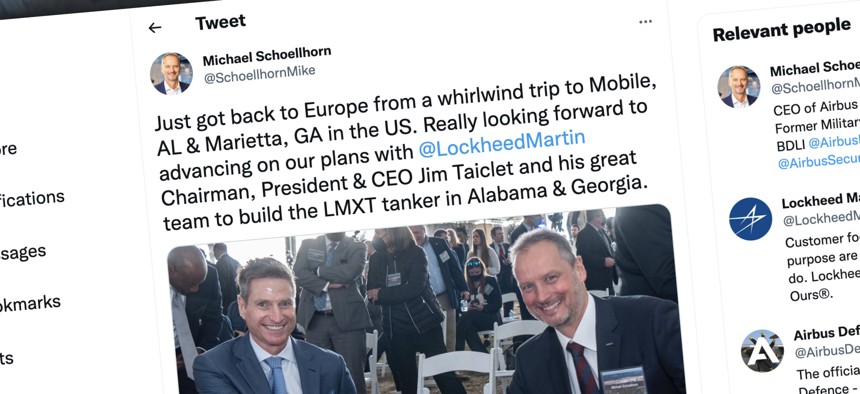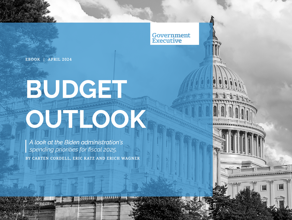Lockheed Secretly Worked to Block Airbus’ Influence in Washington—While Teaming on a Major Pentagon Bid
Internal email reveals U.S. company’s pressure to deny Europeans’ application to powerful trade group.
Under a party tent at an airport in Mobile, Alabama, the CEO of Lockheed Martin grinned as he shook hands with the head of Airbus’s defense and space business unit.
It was late January, and Lockheed’s Jim Taiclet was welcoming Airbus’ Michael Schoellhorn, who had flown in from Europe to help announce a proposal to jointly build aerial refueling tankers at an Airbus plant in the Port City. The campaign-style rally was meant to stir up political support for their bid against Boeing to make the next batch of U.S. Air Force tankers; it had drawn Alabama’s governor, members of the state’s congressional delegation, and state and local officials, all excited by the prospect of hundreds of new jobs.
But back in Washington, Lockheed was quietly trying to block Airbus’ latest application to join the Aerospace Industries Association, an influential trade group that represents hundreds of mostly American companies ranging from multibillion-dollar manufacturers of fighter jets to tiny mom-and-pop suppliers.
Airbus, formed in 1970 when three European firms merged to better compete with American rivals, had applied for membership late last year. AIA’s CEO, Eric Fanning, had scheduled a discussion of that application before the group’s executive committee. That didn’t sit well with Lockheed, whose executives already had grown unhappy with Fanning’s leadership of the lobbying group.
“I remain troubled by how the application has been allowed to even get to the point where there will be an [executive committee] discussion next week,” Christian Marrone, Lockheed’s senior vice president of government affairs, wrote in a Feb. 18 email sent to Peter Prowitt, AIA’s chief operating officer, and copied to several other defense executives. Defense One reviewed the message, which was verified by two sources.
“From the time Airbus shared with AIA their intent to reapply, Eric should have strongly discouraged them from doing so especially given the deep history on this issue,” Marrone wrote. “However, as we have seen time and again on other issues, Eric failed to act.”
The disclosure of the email gives a rare, behind-the-scenes glimpse of the internal politics of a cutthroat sector in which multibillion-dollar companies ferociously compete in one bidding war while allying to win another. Executives often refer to rival companies as “competi-mates,” a play on the words competitor and teammate.
Late last month, Lockheed’s executives told AIA they were suspending its membership in the association. Taiclet, who became Lockheed’s CEO in June 2020, is no longer listed as an AIA board member on its website.
A Lockheed spokesperson did not respond to questions about the email, but confirmed that the company had suspended its AIA membership and that it had recently joined the National Association of Manufacturers.
“Lockheed Martin routinely evaluates our memberships in industry associations to most efficiently support our long-term objectives,” the spokesperson wrote. “Following an assessment, we have rejoined the National Association of Manufacturers and continue our work with the National Defense Industrial Association and Professional Services Council, but do not plan to continue our membership in the Aerospace Industries Association at this time.”
Asked about Lockheed’s departure, an AIA spokesperson said: “Every company makes decisions about its industry relations and advocacy strategy. AIA understands that because we represent the full ecosystem of small, medium, and large companies.
“Bipartisanship, collaboration, and consensus are at the heart of what AIA does, and are essential to effectively advocating for the entire aerospace and defense industry,” the spokesperson said in an emailed statement. “We will continue to rely on this cooperative approach—as we have for more than 100 years—to speak with a unified voice in support of the priorities of our more than 320 members.”
Marrone, a former special assistant to Defense Secretary Robert Gates and later chief of staff to Homeland Security Secretary Jeh Johnson, worked for AIA as vice president for national security and acquisition policy between 2013 and 2014. He and Fanning both served in the Obama administration's Pentagon. But more recently, Marrone has become Lockheed’s leading critic of Fanning’s AIA tenure.
In his email, Marrone argued that the CEOs who make up AIA’s executive committee “should never be placed in such a position” to explain why they are opposed. He wrote that Lockheed’s position—that the group should reject Airbus’ application—has not changed and that the matter should be addressed by an AIA panel made up of lower-level company executives.
“I put forward this arrangement not as an ask, but a demand,” Marrone wrote. “Eric’s failure here should not result in CEOs having to engage on a matter that has been asked and answered with great fanfare several times in the past.”
Marrone wrote that he had sent the message to “several of my colleagues” at other defense firms “to provide them the benefit of our Lockheed position.”
Over the past year, Lockheed executives have become increasingly frustrated with AIA’s focus on commercial aerospace issues over defense issues, according to a person familiar with the company’s position. That person played down the email, saying it was intended to express frustration with the handling of the application and not a reflection about the company’s opinion about Airbus.
Despite Lockheed’s opposition to Airbus’ joining AIA, not all U.S. firms feel that way. Last year, several of Airbus’ American-based suppliers urged the company to apply for AIA membership.
The European company spends tens of billions of dollars annually on U.S.-made parts for its planes, and that number is growing. Meanwhile, the biggest U.S. aerospace company, Boeing, was in crisis, with problems in both its military and civil business segments. With U.S. parts suppliers increasingly dependent on Airbus, they argued, the company should have a seat when executives get together to discuss issues facing the aerospace and defense sector, an industry source said.
Like Lockheed, Boeing had long opposed Airbus’ membership in AIA, according to numerous people familiar with the company’s position, but its most vocal opponent in Washington—former chief lobbyist Tim Keating—left the company in June. Airbus had planned to submit an application to join AIA in the fall, well before the association’s CEO-filled board met in early December, but instead submitted its application a few weeks later, just before Christmas, the industry source said.
AIA formally rejected Airbus’ application in late February, a company spokesperson said.
“As a matter of AIA policy, our association does not comment on the confidential discussions of our CEO-led Executive Committee,” the AIA spokesperson said. “This includes the status of any membership applications. Airbus is an Associate Member in good standing at AIA.”
Associate member CEOs cannot serve on the association's executive committee and therefore have less influence. In an email, the Airbus spokesperson said the company had been seeking more dialogue with AIA.
“With a 53-year history of operations in the U.S., more than 30 U.S. locations, four aircraft assembly lines with thousands of employees here, and $15 [billion] in parts purchased annually from U.S. suppliers, we felt an obligation to our supply chain, employees and the industry to drive meaningful dialog within AIA,” wrote James Darcy, an Airbus spokesperson. “Airbus has played a leading role in our industry’s recovery from the extreme adversity of the past several years, and we will continue to help shape the future of our industry on critical issues and policy decisions, regardless of membership status in this organization.”
In Mobile, site of February’s rally, Airbus builds commercial airliners for Delta Air Lines, JetBlue, and other carriers. This week company officials announced it would increase airplane production in Alabama and create 1,000 new jobs.
Yet Airbus is still widely viewed as a European firm that ferociously competes against Boeing for jetliner sales. For more than a decade, the companies were locked in a trade dispute: Boeing claimed that Airbus was receiving illegal government subsidies that allowed it to sell planes at cheaper prices. It battled Boeing twice in U.S. Air Force refueling tanker competitions. In 2008, the Air Force chose Airbus and its American partner Northrop Grumman to build 179 aircraft, but that deal was canceled after the Government Accountability Office found the Air Force didn’t properly evaluate the two bids. Three years later in a new contest, the Air Force chose the Boeing tanker over Airbus. Now 11 years later, the Boeing tanker still faces technical problems that prevent it from flying all of its intended missions.
Last year, the Air Force began a new effort to buy 160 more tankers. This time, Airbus partnered with Lockheed, the world’s largest defense firm, in its bid to oust Boeing. In March, Air Force Secretary Frank Kendall put the prospects of a competition in doubt, telling reporters that the service might simply order more Boeing tankers.
Airbus would not be the first non-U.S. company admitted to the AIA, whose members include the UK-based BAE Systems and Brazil’s Embraer. Airbus is already a member of the U.S.-based National Defense Industrial Association, another trade group that represents a broader group of defense contractors. But AIA is considered a more exclusive and influential group, since its board is largely made up of the CEOs of the largest defense companies.
The industry source said Lockheed believed that admitting Airbus would further tilt AIA’s focus toward civil aviation and away from defense concerns. In 2020, the coronavirus pandemic turned the commercial aerospace sector on its head leading airlines to ground planes, cancel new orders, and layoff workers as passenger air travel declined in record numbers. The sector has also had to deal with 5G communications signals possibly interfering with aircraft navigation systems. All-the-while, the Pentagon’s budget has been steadily on the rise.
For Lockheed, AIA’s consideration of the Airbus application was on a growing list of frustrations with Fanning, a former Army secretary who held a number of high-level Pentagon posts during the Obama administration, according to industry sources. For instance, the company was frustrated by AIA’s handling of the Biden administration’s vaccine mandate for contractors. Some companies sought approval to require regular COVID tests instead of laying off noncompliant workers amid a tight labor market.
Then in January, the Biden administration sued to block Lockheed’s $4.4 billion acquisition of Aerojet Rocketdyne. Moments before kickoff on Super Bowl Sunday, Lockheed said it would abandon the deal.
The next day, the Biden administration released a 30-page report making a case against consolidation within the defense industry. The report was not well received in C-suites across the sector. For Lockheed, the report was the final straw. Politico first reported Lockheed’s frustration with Fanning over the vaccine mandates and consolidation report.
Marrone, in his email, called the Pentagon report “an existential threat” to the defense industry. He criticized AIA’s response while complementing the responses by the Professional Services Council and NDIA, two other trade organizations that represent a broader group of defense and federal contractors.
“As a result, Lockheed will continue to withhold our dues and refrain from sponsorship opportunities for 2022 until we see meaningful and significant change occur,” Marrone wrote.
Lockheed leaving the organization could do exactly what Marrone feared: push the association to focus more on commercial sales than on defense, the industry source said. And that would benefit Lockheed’s rival: Boeing.




